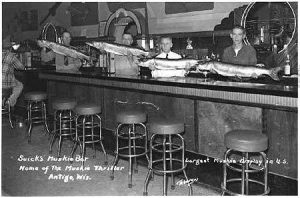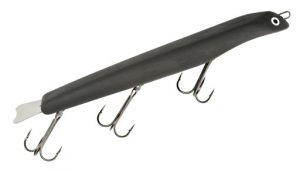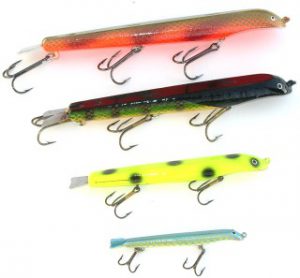The Frank Suick Story
Category: article
Sep 26th, 2019 by Keith Worrall
Modified Sep 26th, 2019 at 9:21 AM
The Frank Suick Story
by Todd Koehn
When the name Suick comes to mind with muskie fisherman they think of “Muskie Thriller” jerk baits. Frank Suick was born in 1899 a month before the turn of the century. In the 1920’s he started fishing Pelican Lake every summer. Making this trip of only 28 miles wasn’t that simple in those days.
Most travel was with Model T Fords and in the late 20’s, Model As. This trip involved traveling on poor, many times impassable roads with time commonly spent fixing flats and other repairs.
Franks parents owned a tavern in Antigo where many of the local Chicago & Northwestern railroad men would come to exchange railroad stories. Antigo was a main hub of this railroad line. From here it tracked north along the east shore of Pelican Lake to Monico Junction just north of Pelican Lake.

Suick’s Musky Bar
Frank developed a close relationship with many of these railroad men. This opened an opportunity for easy travel to Pelican Lake by steam-powered freight train. Once he made the one-hour trip he was dropped off and would rent a boat from Guths Bay Resort or Otis Bait Shop.
In the Pre-Suick days most muskie were caught by casting or trailing suckers behind a rowboat. This was a tedious time consuming method. When a fish finally hit the bait a long wait was required before setting the hook. This could result in the fish dropping the bait. Waiting for this process to be completed is what Suick wanted to eliminate. One day in the early 1930’s he began whittling with a jack knife on a piece of cedar. His handy knife work developed into one of the all time classic jerk baits, the Suick Muskie Thriller.
His new Thriller lure did what he wanted it to accomplish, by simply allowing fishermen to set the hooks as soon as the fish hit. This concept by Suick came from observing trout feeding in one of the many ponds at a hatchery he owned. By this observation he noted that the only time one trout would attack another is when its prey is sick, injured, or off guard. When trying to dip net a sick or injured trout from the pond, he noticed that it would dive down 18 to 20 inches to escape the net and then come back to the surface almost immediately. When this netting was repeated the diving trout attracted others that noticed its weak movements. Soon this floundering fish was attacked by larger fish repeatedly. It is ironic that the principle of the Suick evolved from watching the feeding habits of trout. Trout are the prey of muskie in many of our deep, cold water lakes.

Suick Tail
When whittling out an early prototype to test, Franks knife slipped and cut off part of the cedar tail. This accident soon led to the development of an adjustable stainless steel tail which allows the lure to be tuned to run at different depths.
The earliest color combination was; gray back, white belly with red gill markings. The stainless tail produced a flash which helped improve its attractiveness. The original test baits ran at from 12 to 18 inches below the surface, the same as they do today.
When testing began by Suick at his cottage on Pelican Lake it rapidly became apparent that he had a winner. Soon he had caught and mounted several heads of large muskie on his garage in Antigo. Keep in mind this was before the days of catch and release and the first size limit which was 28 inches. The earliest rod and reel combinations used by Suick were 5 to 5 ½ foot rods made from pool cues or Caluatta canes fitted with guides and Pflueger Supreme reels. This type of cane pole was different from the bamboo cane poles we think of today.
Caluatta is a woody plant stem with knots or knobs that grow closer together than bamboo creating a material twice as strong. These rods were light and had a stiff action capable of heaving suckers long distances.
Braided steel leaders were used for years. Frank was always looking for an alternative because the braided wire would fray and break where the swivel or sleeve was attached. Frank soon discovered a source for piano wire and began to make his own leaders.
The boats of this day were 14-foot wooden shallow V hulls with a narrow bow. Most fishermen stood on the bench seats for better visibility while wearing Polaroid sunglasses bought from drug stores.
Soon after this new Suick lure was perfected the news of Franks incredible catch of 30 muskies in 30 days got out! Many serious muskie fishermen tried to beg, borrow or steal more information about his success and the new mystery Suick lure.
A few Antigo area fishermen got together and decided to put together a petition as a joke to prohibit Frank Suick from fishing on Pelican Lake.
This Petition reads,
“Gentlemen,We, the undersigned hereby petition your honorable body and the Honorable Governor of the State of Wisconsin, to hereby issue an order to prohibit Frank Suick of the city of Antigo, County of Langlade, State of Wisconsin from fishing or taking of fish in Pelican Lake, located in Oneida County, until such time whereby other fisherman are able to catch fish out of the above mentioned lake. We hereby do this in the interest of Muskies at large.”

Suick Thriller HI (Black)
There was one Pelican Lake cottage owner that didn’t take this petition as a joke! He said he would refuse to pay his taxes for that year if Suick continued fishing there. Over 60 signatures were documented.
Muskie anglers traveling through Antigo on their way north would stop at Frank Suicks tavern the “Muskie Bar” to try to get a glimpse of his new lure. This bait was the first commercially produced jerk bait which was first offered for sale in 1942.
During World War II it became difficult to find good treble hooks and rivets to mount the lures’ adjustable tail. Auto brake shoe rivets were the only available fasteners at this time. Many of Suicks friends traveled through other cities and would stop at auto repair shops and buy whatever brake shoe rivets they had.
In the late 1940’s his tavern and dinning room was a big attraction since it had the largest display of muskie mounts and heads in the world. The weekends were always busy, with the bar and dinning room full.
Many taverns serving food during this time period had a separate room. The bar room was for men only, and women when escorted by a man. The tavern dinning room was open for everyone. Times certainly have changed since then!
Suick was known as a die-hard muskie fisherman. Once he was on Pelican Lake it was hard to get him off the water. Suick’s wife told a local newspaper reporter “he is so crazy about catching muskies that when he falls asleep, he often dreams of fighting fish and would actually reach back and clutch a bedpost and pull on it like it was one of his rods.”
Once his lure was established as an essential lure for the muskie fisherman, Frank got mixed up with a commercial motion picture photographer. This experience is one that irked the “old muskie professor.”
The motion picture photographer was in the Pelican lake area filming a commercial for an outboard engine manufacturer and a brand of lures other than the Suick Muskie Thriller. After several fruitless days the photographer had not a single fish. He talked the “old muskie professor” into guiding him.
Suick told him he knew where there was a nice fish hanging out, Frank took him to the spot and after a few casts Suick struck this fish hard. The weather conditions were excellent for filming the ensuing fight. With the camera rolling the whole episode was captured on film. Soon a nice 24-pound fish was in the boat, another victim of the Suick Muskie Thriller.
Many months later the photographer sent Suick a sample film to view. As he watched, Frank couldn’t believe his eyes. The edited movie included a lure but not the Suick Muskie Thriller. The fish had another lure hanging out of its’ mouth. From this point on, Frank became wary of promoters.
Suick was the master of Pelican Lake because he studied muskie and knew their feeding habits. One local angler said “it was like he could crawl under the skin of a muskie, better enabling him to understand their daily routines.”
With Frank gaining notoriety as the “Muskie Professor” Heddon Tackle Co. had him specially design many different muskie rods. Heddon made several rods for Frank with the custom inscription “Made by Heddon Specially for Frank Suick.” These custom Heddon rods were the last ones he used until his death in the mid seventies.
Franks largest fish was taken on a 9 inch “Suick Muskie Thriller,” a 46 pounder from Pelican Lake.
Franks two sons John “Pete” and Jim took over the lure business in 1951. The original 9-inch model of the muskie thriller didn’t take off until 1960. The 7-inch Thriller went into production in 1956 followed by the 4 inch in 1985 and the Super 10 inch in 1987.
The small 4′ bass style is made in two different designs. These lures are made of plastic which eliminates the stainless steel tail. Without the adjustable tail they cannot be tuned to run at different depths, hence the two different models a floater and sinker.

suick thriilers collage
Today the business is operated by Frank’s grandson Steve Suick. In 2011 there are over 30 different color combinations with the exception of the 4′ inch which has 17.
Many different game fish are taken on Suicks of all colors and sizes. In Northern Minnesota and Ontario not only is it known as a top muskie lure but also trophy northern pike producer.
Although Frank Suick was best known as a muskie fisherman, his first love, he was also enjoyed many other forms of fishing. Few people realize Frank enjoyed chasing trout and would often spend an entire day on the famous Wolf River with a fly rod. Bass and panfish were species he pursued with a passion during spring before muskie action began. This broad experience probably made him a better muskie fisherman.
Every muskie box deserves a piece of history like this famous jerk bait. Remember what Frank Suick always said, “The Bait That Thrills Muskie and You!